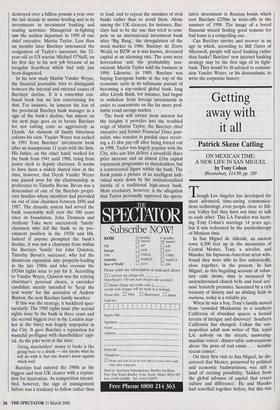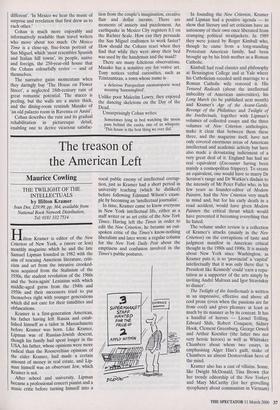Getting away with it all
Patrick Skene Catling
ON MEXICAN TIME: A NEW LIFE IN SAN MIGUEL by Tony Cohan Bloomsbury, £14.99, pp. 289 Though Los Angeles has developed the most advanced, time-saving communica- tions technology, even people close to Sili- con Valley feel they have not time to talk to each other. This LA Paradox was harm- ing Tony Cohan's marriage 14 years ago, but it was redeemed by the psychotherapy of Mexican time.
In San Miguel de Allende, an ancient town 6,300 feet up in the mountains of Central Mexico, Tony, a novelist, and Masako, his Japanese-American artist wife, found they were able to live unhurriedly, close together, in the present. In San Miguel, as this beguiling account of volun- tary exile shows, time is measured by unsynchronised church bells and local arti- sans' leisurely promises. Sustained by a rich treasury of history and an abiding faith in mariana, today is a reliable joy.
When he was a boy, Tony's family moved from 'crowded Manhattan to a southern California of abundant spaces: a fecund terrain of intrigue and discovery'. Southern California has changed. Cohan the cos- mopolitan adult now writes of 'flat, tepid LA: nobody on the streets, answering- machine voices', dinner-table conversations about 'the price of real estate . . . notable recent crimes'.
On their first visit to San Miguel, he dis- covered that Mexico, preserved by political and economic backwardness, was still a land of exciting possibility, 'hidden from the global advance of capital that erases culture and difference'. He and Masako had travelled together before, but this was different'. 'In Mexico we hear the music of surprise and revelation that first drew us to each other.'
Cohan is much more enjoyably and informatively readable than travel writers who move about too much. On Mexico Time is a close-up, fine-focus portrait of San Miguel, which 'most resembles Spanish and Italian hill towns', its people, native and foreign, the 250-year-old house that the Cohans colourfully revive — and of themselves.
The narrative gains momentum when they daringly buy 'The House on Flower Street', a neglected 18th-century ruin of great romantic potential. The stucco is peeling, but the walls are a metre thick, and the dining-room reminds Masako of `an old palazzo room in Ravenna or Assisi'. Cohan describes the ruin and its gradual rehabilitation in picturesque detail, enabling one to derive vicarious satisfac- tion from the couple's imagination, creative flair and dollar income. There are moments of anxiety and puzzlement. An earthquake in Mexico City registers 8.1 on the Richter Scale. How can they persuade the San Miguel craftsmen to work faster? How should the Cohans react when they find that while they were away their bed was used by the handyman and the maid?
There are many felicitous observations. Masako has a sensitive eye for votive art. Tony notices verbal curiosities, such as Tzintzuntzan, a town whose name is a delicious Purepechan onomatopoeic word meaning 'hummingbird'.
Unlike poor Malcolm Lowry, they enjoyed the dancing skeletons on the Day of the Dead.
Unsurprisingly Cohan writes: Sometimes lying in bed watching the moon pass behind the casita, one of us whispers: `This house is the best thing we ever did.'



































































 Previous page
Previous page